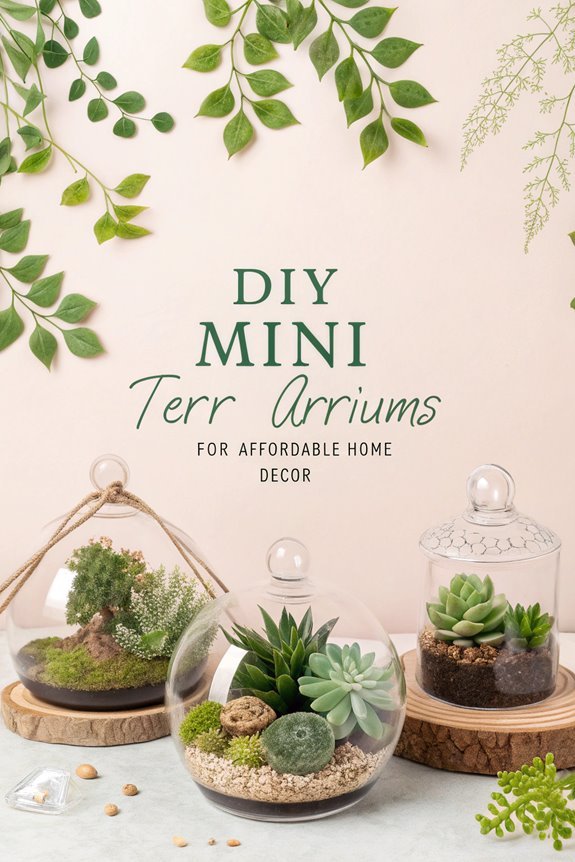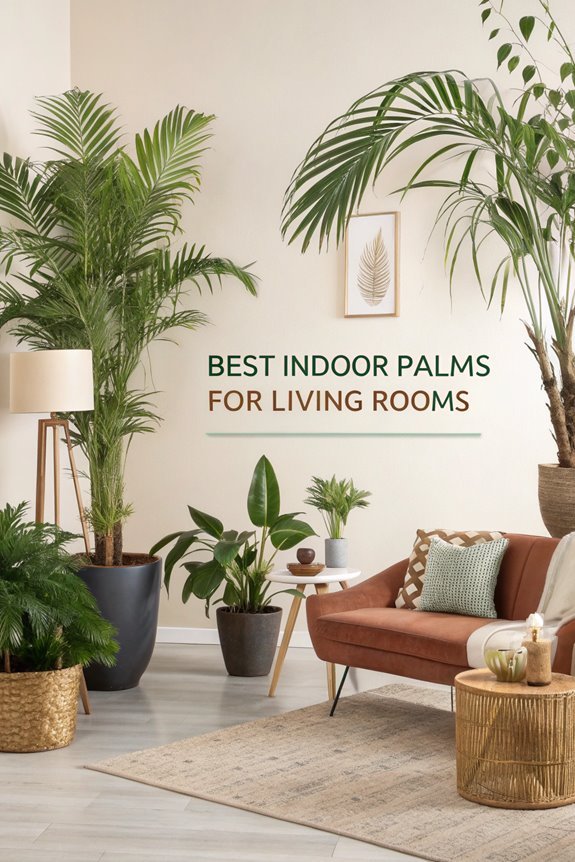15 Succulent and Cactus Combos for Desert Rock Gardens
Transform your outdoor space into a stunning desert oasis with these 15 succulent and cactus combos for your rock garden! From the striking heights of Agave and Echinopsis to the playful textures of Sedum and Opuntia, there’s a perfect pairing for every aesthetic.
These delightful combinations offer beauty and low-maintenance options that will impress anyone who visits. Get ready to create a vibrant landscape that thrives in sunny conditions!
Agave and Echinopsis

When you think about creating a stunning desert rock garden, why not start with the dynamic duo of Agave and Echinopsis?
Agave, with its bold, architectural leaves, adds a striking presence, while Echinopsis, blooming with vibrant flowers, brings a pop of color that’ll make you smile.
Together, they thrive in the sun and require minimal water, perfect for keeping your garden low-maintenance.
Plus, they’re like the ultimate team—Agave stands tall, and Echinopsis bursts into a beautiful display!
Aloe Vera and Golden Barrel Cactus

If you’re looking to add a touch of the extraordinary to your desert rock garden, consider the fabulous pairing of Aloe Vera and Golden Barrel Cactus!
Aloe Vera brings its lush, green leaves and healing properties, while the Golden Barrel Cactus adds a striking, spiky contrast with its vibrant yellow blooms.
Imagine them basking in the sun, creating a delightful desert oasis! Plus, they’re both low-maintenance—perfect for those who want beauty without the fuss.
Just remember, while Aloe’s got your back for soothing burns, the Golden Barrel’s got those prickly vibes.
Together, they’ll make your garden pop with personality!
Sedum and Opuntia

Looking to spice up your desert rock garden? Pairing Sedum and Opuntia is a match made in cactus heaven!
Sedum, with its vibrant green leaves and stunning flowers, brings a splash of color, while Opuntia, the prickly pear cactus, adds that iconic desert vibe. They thrive in similar conditions, so you won’t have to worry about compatibility.
Just imagine those juicy Opuntia pads next to the lush Sedum – it’s a sight that’ll make your neighbors envious! Plus, this combo requires minimal watering, giving you more time to enjoy your beautiful garden instead of fussing over it. Fun and easy!
Haworthia and Mammillaria
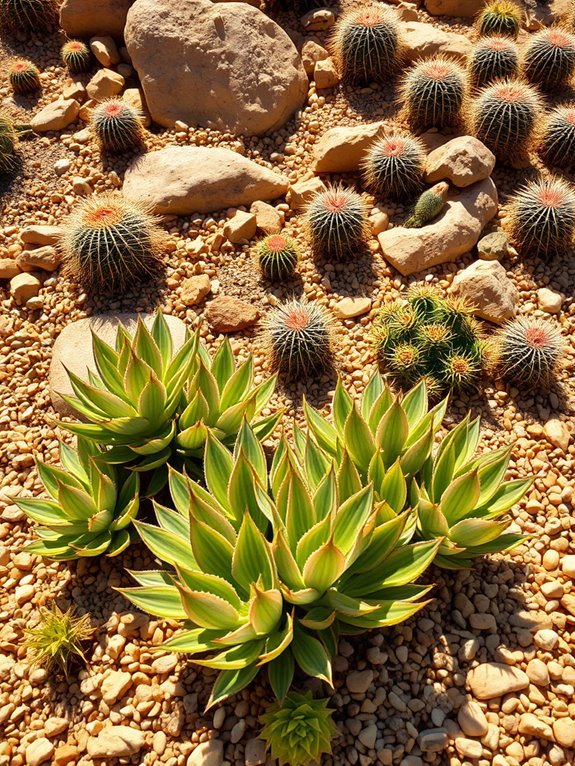
After enjoying the colorful charm of Sedum and Opuntia, why not explore another fabulous pairing for your desert rock garden?
Haworthia, with its striking rosettes and lush, green leaves, brings a touch of elegance. It loves shade, so you can tuck it in cozy spots.
Pair it with the cheerful Mammillaria, a cactus bursting with tiny, vibrant flowers and spines that seem to wave hello! This duo thrives together, offering a delightful contrast of textures.
Plus, they don’t ask for much—just a bit of water and sunlight. Who knew gardening could be this easy and fun? Get ready to smile!
Jade Plant and Saguaro Cactus

When you want to create a stunning desert rock garden, consider teaming up the beloved Jade Plant with the iconic Saguaro Cactus.
The Jade Plant, with its lush, rounded leaves, brings a touch of vibrant green, while the Saguaro stands tall, sporting its impressive arms. Together, they create a delightful contrast!
Plant them in a sunny spot, and watch them thrive. Just make sure to give the Jade Plant a little more water than the Saguaro, who’s quite happy in dry conditions.
With this combo, your garden won’t only look great but might just make your neighbors a little envious!
Graptopetalum and Ferocactus
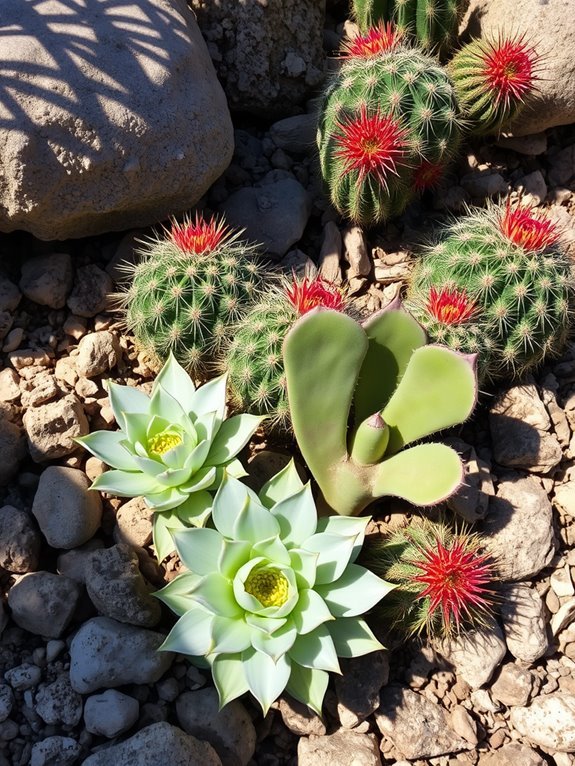
You’ve had your fun with the Jade Plant and Saguaro Cactus, but if you’re ready to shake things up a bit, let’s talk about the fabulous duo of Graptopetalum and Ferocactus!
These two bring a delightful mix of colors and textures to your desert rock garden. Here’s why you’ll love them:
- Colorful Leaves: Graptopetalum showcases pastel hues that pop!
- Bold Spines: Ferocactus adds drama with its fierce, eye-catching spines.
- Low Maintenance: Both love the sun and require minimal watering.
- Unique Shapes: Their contrasting forms create visual interest.
Get ready to wow your garden visitors!
Sempervivum and Parodia
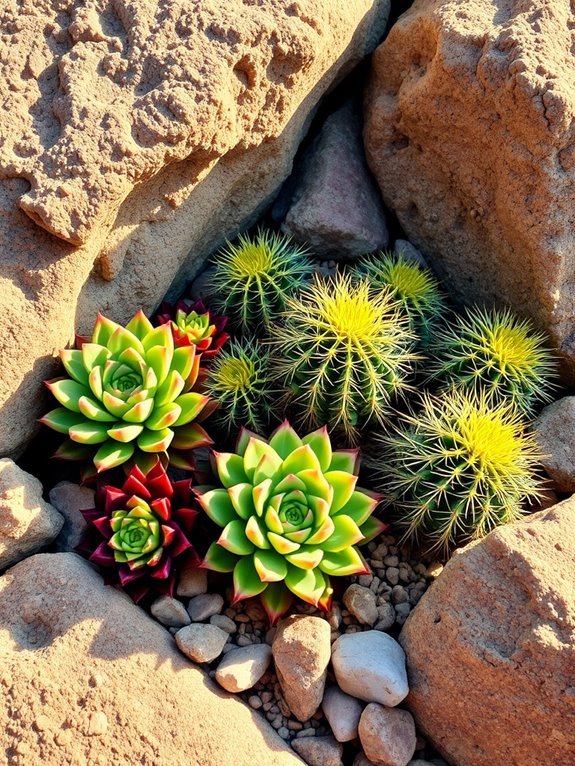
If you’re looking to add some pizzazz to your desert rock garden, Sempervivum and Parodia are just the duo you need!
Sempervivum, with its rosette shapes and vibrant colors, creates a stunning backdrop. Pair that with the charming roundness of Parodia’s spines, and you’ve got a match made in desert heaven!
These two thrive in similar conditions, so you won’t have to stress over their care. Just make sure they get plenty of sunlight and well-draining soil.
Plus, they’ll have you looking like a rock star gardener—just don’t let it go to your head! Happy planting!
Crassula and Stenocactus
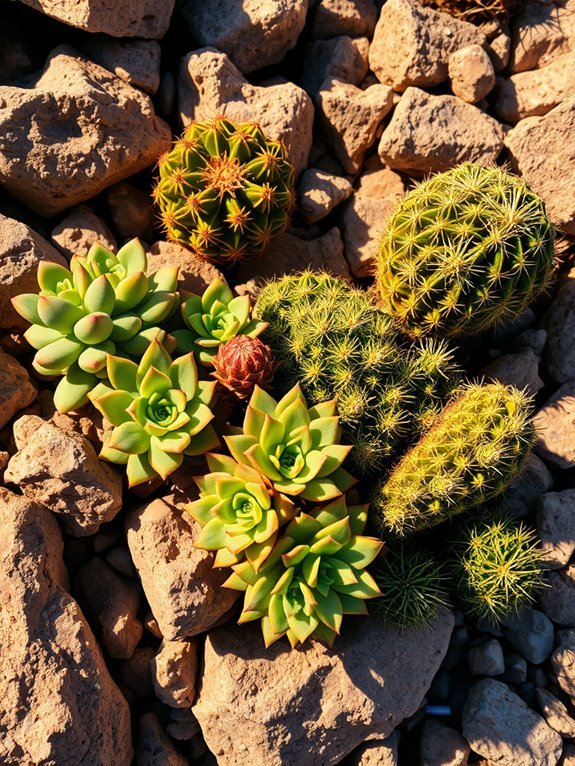
Crassula and Stenocactus make a dynamic duo that can breathe life into any desert rock garden!
These two not only look great together, but they also thrive in similar conditions.
Here’s why you’ll love this combo:
- Variety: Crassula offers lush, vibrant colors, while Stenocactus brings unique shapes and textures.
- Low Maintenance: Both are drought-tolerant, so you won’t need to water them often.
- Pest Resistance: They’re tough cookies, less likely to fall prey to pests.
- Visual Interest: Their contrasting forms create a stunning visual display.
Get ready to enjoy your flourishing garden!
Aeonium and Pincushion Cactus
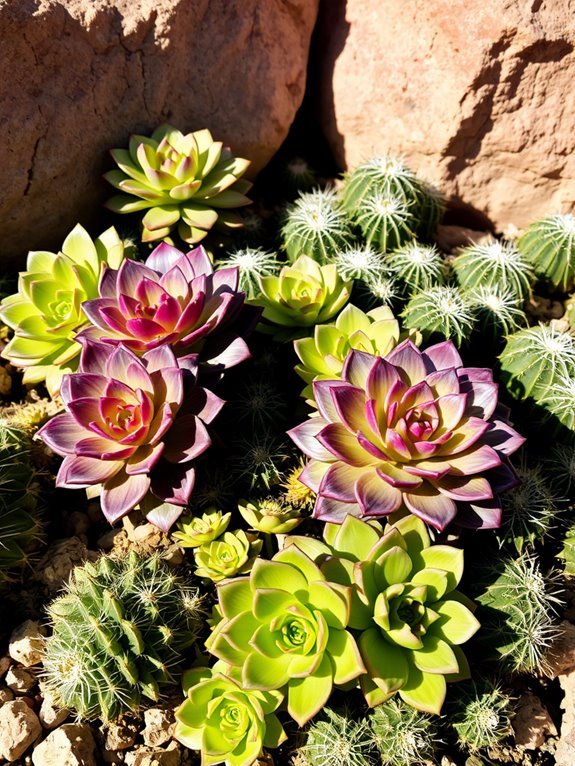
After enjoying the delightful pairing of Crassula and Stenocactus, let’s explore another fantastic duo: Aeonium and Pincushion Cactus!
Imagine the vibrant rosettes of Aeonium contrasting beautifully with the spiky charm of Pincushion Cactus.
You’ll love how Aeonium’s lush green leaves bring a pop of color, while the Pincushion adds that quirky, playful touch with its adorable clusters of spines.
Plant them together for a stunning display that’s sure to turn heads.
Plus, they both thrive in similar conditions, so caring for this duo is a breeze!
It’s like hosting a party with the coolest guests—fun and low-maintenance!
Kalanchoe and Cereus
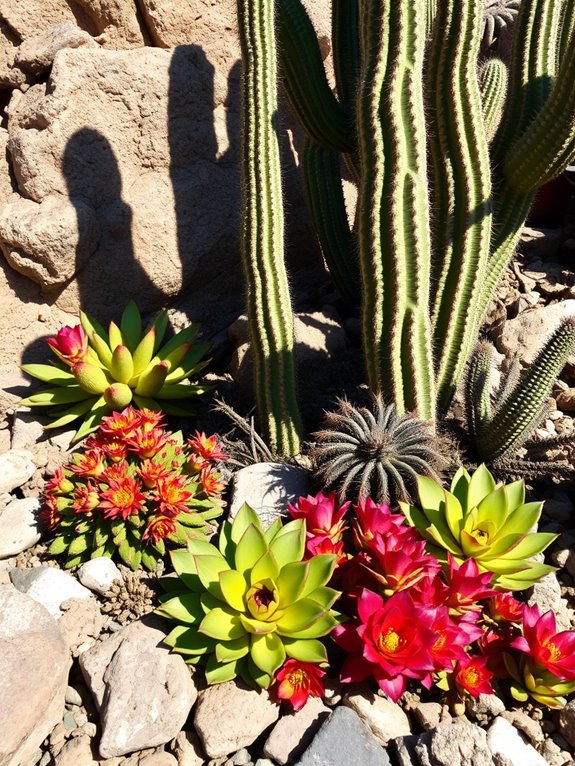
As you immerse yourself in the world of desert rock gardens, you’ll discover that the pairing of Kalanchoe and Cereus is nothing short of sensational!
These two desert dwellers bring color and character together like peanut butter and jelly. Here’s why you’ll love this combo:
- Vibrant Blooms: Kalanchoe’s bright flowers contrast beautifully with Cereus’s tall, majestic form.
- Low Maintenance: Both thrive on neglect—perfect for busy folks!
- Drought Tolerant: They laugh in the face of dry conditions.
- Textural Delight: The rounded leaves of Kalanchoe mix wonderfully with the spiny elegance of Cereus.
What’s not to love?
Lithops and Astrophytum

If you’re looking to add a unique flair to your desert rock garden, you’ve got to contemplate the dynamic duo of Lithops and Astrophytum!
These charming plants, often called “living stones,” will catch your eye with their quirky shapes and colors. Lithops mimic pebbles, making them a fun surprise for your guests.
Meanwhile, Astrophytum boasts stunning star-like patterns, standing tall and proud. Together, they create a delightful contrast—one low and discreet, the other bold and striking.
Plus, they’re low-maintenance! Just guarantee they get plenty of sunlight and avoid overwatering.
Trust me, your garden’s going to be the talk of the town!
Echeveria and Lophophora

When you think about creating a vibrant desert rock garden, Echeveria and Lophophora might just be the dream team you didn’t know you needed!
These stunning plants complement each other beautifully, with Echeveria’s rosette shapes paired with Lophophora’s unique round forms. They not only look great together but also thrive in similar conditions.
Here’s why you’ll love them:
- Color Variety: Echeveria offers bold colors, while Lophophora brings subtle greens.
- Low Maintenance: Both are easy to care for—perfect for busy gardeners!
- Drought Tolerance: They don’t mind dry spells.
- Unique Textures: Mix it up for visual interest!
Senecio and Notocactus
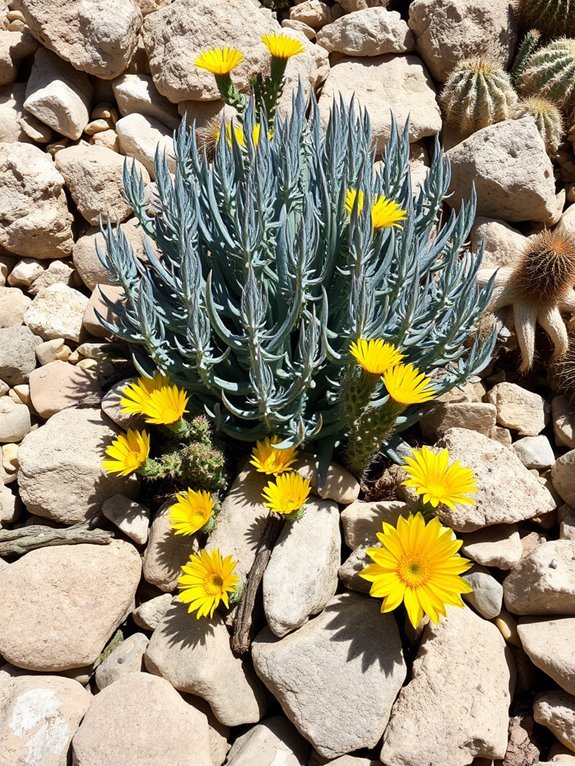
Ready to elevate your desert rock garden? Pairing Senecio and Notocactus is a match made in botanical heaven!
Senecio, with its vibrant, trailing leaves, adds a splash of color and drama, while Notocactus brings charming round shapes and striking blooms.
Imagine their textures mingling together; it’s like nature’s own art installation! Plus, these plants are tough cookies, thriving in the sun and requiring minimal water.
You won’t have to babysit them! Just sit back, relax, and watch your garden flourish.
Go ahead, mix these two, and create a stunning visual feast that’ll make your neighbors green with envy!
Dudleya and Gymnocalycium

After enjoying the vibrant duo of Senecio and Notocactus, it’s time to explore another fabulous pairing: Dudleya and Gymnocalycium!
These two aren’t just great companions; they bring a delightful mix of textures and colors to your garden.
Here’s why you’ll love them together:
- Dudleya’s rosettes add a stunning architectural appeal.
- Gymnocalycium’s blooms burst with color, attracting pollinators.
- Low maintenance means more time to enjoy your garden.
- Drought-tolerant nature guarantees they thrive in sunny spots.
Cotyledon and Rebutia
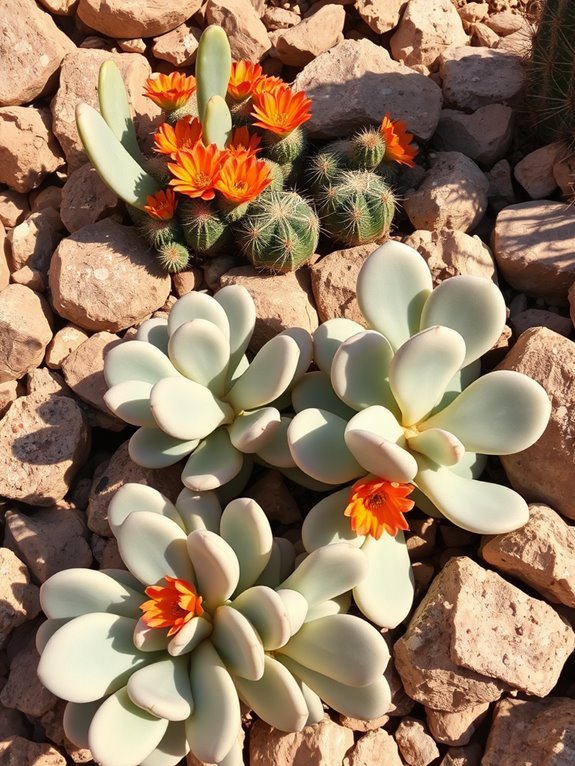
If you’re looking to add a splash of personality to your desert rock garden, Cotyledon and Rebutia make a match made in heaven!
These two plants bring vibrant colors and unique shapes to your landscape. Cotyledon’s plump, fleshy leaves create a lush backdrop, while Rebutia dazzles with its eye-catching flowers, blooming in shades of red, orange, or yellow.
Plant them together for a stunning contrast that’ll have your neighbors green with envy! Plus, they’re low-maintenance, so you can enjoy your garden without constant upkeep.
Just remember, they thrive in well-draining soil and plenty of sunlight—sunshine is their secret ingredient!
Frequently Asked Questions
How Often Should I Water My Desert Rock Garden Plants?
You should water your desert rock garden plants sparingly. Generally, once every two to three weeks is enough. Always check the soil moisture first; it’s better to underwater than overwater these drought-tolerant plants.
What Soil Type Is Best for Succulents and Cacti?
For succulents and cacti, you’ll want well-draining soil. A mix of potting soil, sand, and perlite works great, allowing excess water to escape while providing essential nutrients. Avoid heavy soils that retain moisture too long.
Can I Mix Different Types of Succulents and Cacti?
Sure, you can mix different types of succulents and cacti! It’s like throwing a party for plants—some thrive together, while others might create chaos. Just guarantee they share similar care needs for a harmonious garden.
What Pests Should I Watch Out for in My Garden?
In your garden, watch out for aphids, mealybugs, and spider mites. These pests can damage your plants. Regularly inspect your plants and treat any infestations promptly to keep your garden healthy and thriving.
How Do I Propagate Succulents and Cacti Effectively?
To propagate succulents and cacti effectively, you’ll want to take healthy cuttings, let them callous for a few days, then place them in well-draining soil. Water sparingly until roots develop, and watch them thrive!
Conclusion
Whether you’re a seasoned gardener or a beginner, these succulent and cactus combos will transform your desert rock garden into a vibrant oasis. Picture the striking contrast of spiky Agave with blooming Echinopsis or the gentle Aloe Vera alongside the prickly Golden Barrel Cactus.
With minimal maintenance, you can create a stunning landscape that attracts pollinators and garners compliments. Get ready to dig in and unleash your creativity—it’s time to let those plants shine!


